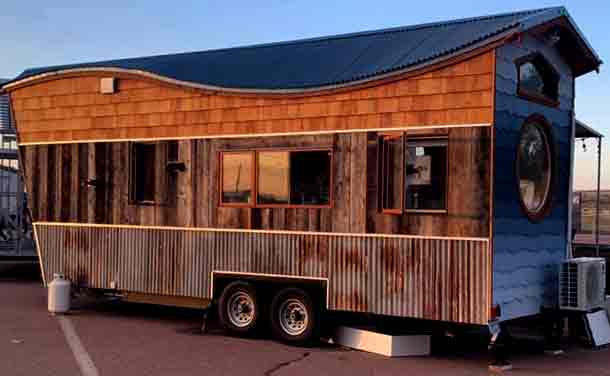Buying A Used Tiny House: What To Look For
As the prices of conventional dwellings continue to skyrocket, you may be thinking of purchasing a tiny home.
Look before you leap! Buying a used tiny home is far more complicated than you might think. THOWs (tiny house on wheels) have a specific set of criteria you must be aware of before you sign on the dotted line. Likewise, tiny abodes on foundations (THOFs) generally must submit to the same standards as stick houses. Because tiny housing is a relatively new and rapidly-changing field, keeping up with the latest developments is critical.
The current owners of the tiny homes that are now for sale started out with a dream. As this movement matures, many who have lived in tiny homes have reasons to move on. They may have met their goals of saving money, being more ecologically minded, or just wanting to do something different. Many of these families have grown and as a result, they need more space. So now we have a used tiny house market beginning.
A used tiny house might be an excellent avenue for you to meet your goals. But how do you know that the tiny house you’re looking at is in good shape and safe to live in? Your proactive approach to this question can make or break your home-buying experience.
THOWs and THOFs: Concerns They Share and Structure-Specific Issues
If the tiny house is on wheels you’ll be buying a trailer with a decorative load. There’s not a lot of paperwork beyond a DMV title. However, just because you don’t need much to complete the transfer of ownership doesn’t negate the need for a critical inspection of the house’s infrastructure. Also, you will be placing your THOW on a piece of land somewhere. You would be wise to research that location’s zoning laws and codes, as wells as your prospective house’s compatibility with any possible change in climate.
If the tiny home is on a permanent foundation you’ll be buying real estate. There is a ton of paperwork and regulations that need to be followed. You will need a clean inspection to qualify for a mortgage as well as insurance. Knowledge is power, and having them both will save you both headaches and money.
Tiny Home Buyer’s Guide: How to Buy a Tiny Home on Wheels
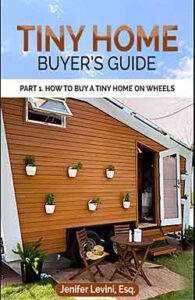
While the worldwide masses have embraced Tiny Homes on Wheels (THOWs) as a solution to living sustainably and affordably, it is still almost impossible to buy one with confidence. Buyers cannot easily differentiate safe from unsafe, and legal from illegal because the laws and standards which govern these vehicles are a mishmash of complicated codes. This has given rise to dozens of unscrupulous builders who sell unsafe tiny homes, or worse yet, take money from hopeful buyers and never deliver any product. Housing lawyer, Jenifer Levini, breaks down all the building standards, to easily explain:
- The distinct types of tiny homes;
- How tiny homes are alike and different from recreational vehicles;
- All the building codes and standards used to build THOWs;
- Why third-party certification is important;
- How to recognize an illegal tiny home and unsafe manufacturer;
- The necessary parts of a purchase contract to protect the buyer; and
- Practical considerations in buying your first tiny home.
Part 1 of the Tiny Home Buyer’s Guide series has pictures to help you learn to spot the telltale signs of unsafe THOWs and a check list to guide you step-by-step through the tiny house purchase process. Do not give any money to a tiny home builder or seller without reading this guide first.
For more about the author visit this page: Building and Living Legally In Tiny Homes.
An inspection will be necessary if you intend on getting financing
Are there qualified inspectors? You may need to gain the knowledge of what to watch out for yourself.
There are different building codes depending on the type of construction. Is it on wheels or a foundation?
Professional Tiny House Builder or Home-Built?
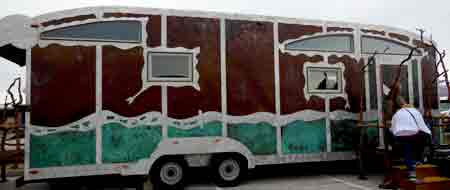
This tiny house was built by an artist. The exterior is very strange but the interior is spectacular. Was attention paid to building codes?
Was the house built by a professional tiny house building company? Let’s see the sales receipt. Builders learn as they go, so in many cases their later models are better than the early ones they’ve built.
Was it built by the current owner? Use extra care to determine the quality of the build. See if they have a video diary or photos of the build process. Ask why they’re selling it.
You can find some very strange and interesting building methods from the your average backyard builder who does not keep building codes in mind during construction. But sometimes they are pretty cool.
Always Look Underneath for a Professionally-Built Tiny Home Trailer

Tiny homes and RVs are different. If we are talking about buying a used RV or travel trailer, I would strongly advise to check out the roof. They are notoriously leaky. Tiny home roofs are not, but there are some other common issues you need to look out for.
Get down on the ground and look at the trailer the tiny home is built on. If you see a reused travel trailer frame just walk away immediately.
Check the trailer weight rating on the VIN plate and ask what the weight of the built trailer is. If the seller doesn’t know, ask if you can have it weighed. Make sure the tiny house is not too heavy for the trailer it’s on.
Check for trailer brakes
With this much weight, the trailer must have its own electronic braking system to be safely moved. See this page of our website for details on trailer brakes:
Title
Make sure the seller has a clear title and the VIN number on the trailer matches the VIN on the title. Make sure the seller’s name is on the title.
Water Damage
Look for leaky windows. Frequently an inexperienced home builder will install the windowsill or flashing improperly, and water will ooze into the house. Water damage will be seen below the window. Skylights are also a common water leak area.
Doors might be hard to open because they’re scraping on the floor, which is a sure sign of water ingress and frame torque (sometimes called racking).
Look for mold, even mushrooms, growing in kitchen cabinets, behind the toilet, and under the sinks.
Safety
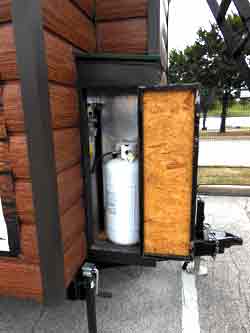
Check that the lofts have an egress window and landing that meet the requirements of the fire safety code.
Electrical: You may need a qualified electrician to determine if the home is wired safely. Is there a certified breaker box? Is it adequately grounded? Are there GFI outlets in the required areas?
Is there on-board propane storage? Is that area properly constructed and vented? Propane tanks should never be housed inside an enclosed area. Exterior enclosures must be vented out the bottom.
The tiny house must have smoke, propane, and carbon monoxide detectors. There should be a fire extinguisher on hand.
Build Features
Framing
Use a stud sensor to check for studs 16′ on center.
Look for doors and windows that don’t open easily. This is a sign that the frame has been torqued (racked) during a move.
Was the house built for the climate you’ll be living in? Could it, for instance, handle a snow load?
Check insulation
Kill the power to the house, then remove an electrical outlet cover and shine a light into the wall next to the outlet box. This will give you access to the inside of the wall to determine what kind of insulation is in the wall.
Does the design support your living style?
Does it have a composting or flush toilet? Which did you want? Where does the flush toilet flush? City sewer or holding tanks?
Can you climb the ladder to the loft? Are there enough sleeping spaces? Is there acoustical separation affording privacy spaces?
Heating and Cooling
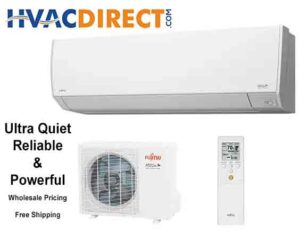
Do they have a heating system? I would recommend two sources of heat if you’ll be living in a cold climate.
Do they have an air circulation system?
Air conditioner? If it’s a combo, is the mini-split (heat pump) enough to heat sufficiently in the winter?
Venting
Is there a range hood vented outside? Do they have a “make-up” air inlet?
Do they have an externally-vented bathroom fan?
Check the tires
Check the date stamp. If older than 5-years you’ll need to replace them. Check for small cracks in the sidewall caused by the sun. Look for rust on the axles and wheel bearings.
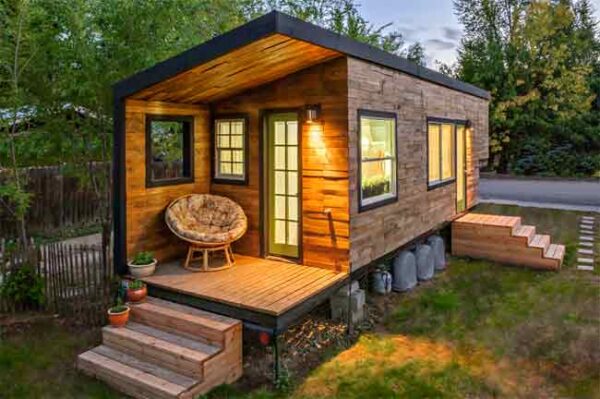
Get it in writing:
Write down every defect you find. Note price concession or promise to repair. Write a guarantee with the seller that is acceptable to you both and both sign it. You will also need a sales contract, disclosure form, and a warranty, at least. OBTAIN LEGAL COUNSEL to go over your contracts before you sign them. If you unfortunately end up in court over an issue, your written documents will be the only admissible proof you have.
Online law services are often faster and cheaper than a local brick-and-mortar legal firm. Do your homework if you decide to go this route. We’ve actually had good luck with this.
Find out if the builder’s warranty is transferable, and if so, have that be part of the deal. Get all of the owners manuals for the appliances. Get receipts for any purchases that were installed, such as appliances, carpet, etc. See if those manufacturer’s warranties are transferable.
If you ain’t got it in writing you ain’t got it.
Get copies of any pictures and video the original builder may have.
Certifications and Building Codes for Tiny Homes
Ask for any certification they may have gotten. If the tiny home is RVIA Certified, that is originally for motor homes and travel trailers. Currently only temporary occupancy is allowed, like a vacation. RVIA laws do not address permanent full-time residences. You need to know the differences to make sure the tiny home you are buying will work for your purposes, and even be allowed on your property.
Here is a YouTube video from Jillian at Far Out Tiny Homes explaining some details about Appendix-Q that apply to tiny homes built to ANSI standards. Many used tiny home on the market today may have been built before Appendix-Q was in existence and do not comply.
In this video Jillian mentions the minimum ceiling height for lofts and that lofts need to be at least 35 sq./ft. and 5′ wide. Stairs must be at least 20″ wide and the risers between 7 and 10 inches in height. There are a lot more details so grab a pen and paper. You can download Appendix-Q here.
Certification Companies
There are “after-construction” certification companies which will sell a builder their “certification.” These certifications have no influence over governmental regulatory agencies but it might give you greater piece of mind knowing that one of the companies says the building quality is OK. These certifications are beginning to be accepted by insurance agencies and financial institutions. As always, do your homework.
Everything look good so far? Hire a certified tiny house inspector
Certified inspectors know the building and fire safety codes.
They will look for things like vapor barriers. Are there the correct amount of toilets connected in the proper way? Are the propane tanks vented properly? Is there a clear title? Things you might not have known to ask about.
Used Tiny House Listings
Many people list their used tiny homes in Facebook Marketplace and specific Facebook groups, Craig’s List, and EBay.
Check out my For Sale page for tips on buying a used tiny home from EBay.


